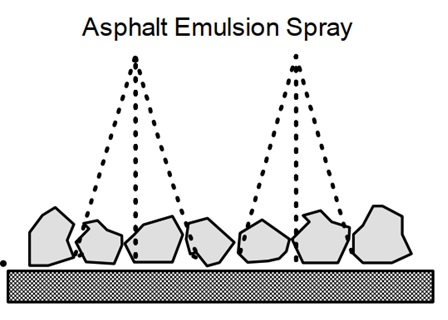fog seal is defined as “a light spray application of dilute asphalt emulsion used primarily to seal an existing asphalt surface to reduce raveling and enrich dry and weathered surfaces.
A fog seal is designed to coat, protect, and/or rejuvenate the existing asphalt binder. The addition of asphalt will also improve the waterproofing of the surface and reduce its aging susceptibility by lowering permeability to water and air. To achieve this, the fog seal material (emulsion) must fill the voids in the surface of the pavement. Therefore, during its application it must have sufficiently low viscosity so as to not break before it penetrates the surface voids of the pavement. This is accomplished by using a slow setting emulsion that is diluted with water. Emulsions that are not adequately diluted with water may not properly penetrate the surface voids resulting in excess asphalt on the surface of the pavement after the emulsion breaks, which can result in a slippery surface. Figure 1 conceptually shows a fog seal application.
 Figure: Schematic of Fog Seal Application
Figure: Schematic of Fog Seal Application
During application, the emulsion wets the surface of the aggregate and the existing binder film. Cationic (positively charged) emulsions can displace water from the surface of an aggregate or aged asphalt film. The emulsion then breaks by loss of water and chemical action, forming a film of new binder on the aggregate and existing binder film. The rate at which the emulsion breaks is dependent on several factors with weather conditions (e.g., wind, rain, temperature, etc.) being dominant factors. For anionic (negatively charged) emulsions, there is no surface specific interaction with most aggregates. The emulsion breaks due to water loss by evaporation and absorption of water by the aggregates and surface voids of the pavement.
The most common cationic emulsion bitumens used for fog seal are CSS-1 and CSS-1h.
